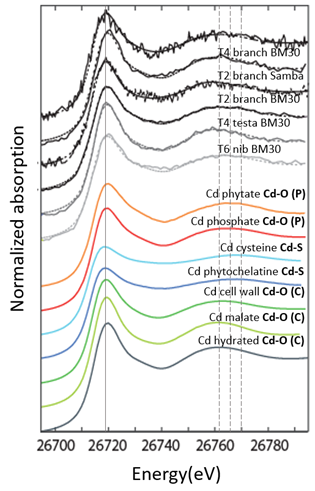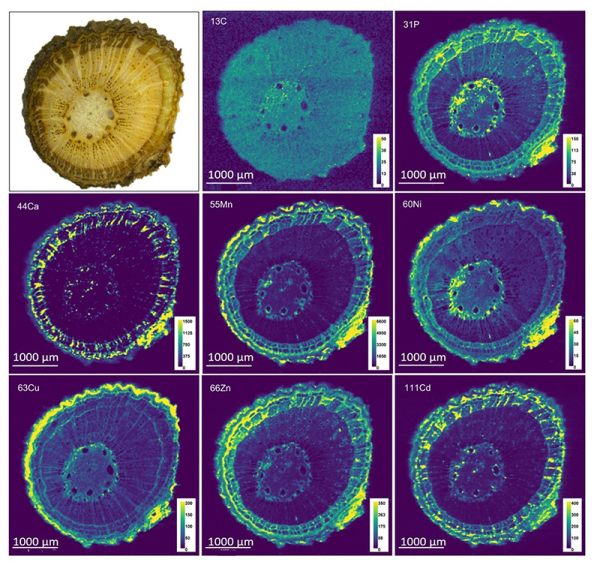The accumulation of cadmium (Cd), a potentially toxic metal, in cocoa beans has recently become a subject of intense research, after the European Union and the Codex Alimentarius* decided to lower the legal limits of cadmium in chocolate. To date, there is a complete lack of knowledge of how Cd is transported from soil to the beans. Therefore, the study summarized here aimed at proposing pathways of Cd within cacao trees. This knowledge can ultimately lead to mitigation strategies to reduce cadmium content in cacao beans, and therefore in our favourite chocolate.
Cadmium (Cd) is a potentially toxic trace metal that has no known biological function in humans and plants. Recent regulations have fueled research worldwide to monitor and mitigate Cd accumulation in cacao. In the short-term, agronomic changes like soil amendments and post-harvest treatments could offer effective and sustainable strategies for Cd mitigation in cacao. In the long-term, breeding low Cd cultivars (type of cultivated plant selected for desired traits and, when propagated, retain those traits) likely provides the highest potential. However, the genetics and breeding research is currently limited by the lack of understanding of how Cd is loaded into the developing cacao fruit of the tree.
The goal of this study was to decipher the transfer of Cd from soil to the bean in a high Cd accumulating cacao cultivar, by combining measurements of Cd stable isotope fractionation, speciation, and localization of Cd in different organs in the cacao tree. An international collaboration was set up.
First, tree samples were collected in the International Cocoa Genebank, Trinidad (ICGT) with the scientists of the Cocoa Research Center. Afterwards, the samples were shipped to Université Grenoble Alpes where bulk analyses were done to assess the elemental content in the plant organs. With the help of the Geochemistry platform of the ENS Lyon and their expertise in stable isotope fractionation, insights in the Cd cycling within trees have been retrieved. At the SAMBA beamline of SOLEIL, the chemical environment of Cd was measured in different organs of the trees by bulk XANES (Figure 1). Together with the imaging of branch cross-sections (Figure 2, performed at KU Leuven, Belgium), this gave insights into the mechanisms the tree uses to accumulate and detoxify Cd.
The combination of data allowed the scientists to propose Cd transfer pathways from soil to nib in a high Cd accumulating cacao cultivar. They extended the limited knowledge on Cd accumulation in perennial, woody crops and revealed that the Cd pathway in cacao is markedly different than in annual crops, like the well-studied cereals, and closer to Cd hyperaccumulating plants. They could identify the woody parts as a major storage compartment, and oxygen-containing molecules as main ligands. Additional studies which identify the corresponding regulating genes will allow breeding programs to produce low Cd accumulating cultivars in the long term.
Lastly, the scientists observed the chemical form of Cd in the nibs, which may have important implications for human nutrition studies: Cd in the nibs may be complexed with phytate – phytate (C6H18O24P6) is the principal storage form of phosphorus in many plant tissues. Because of its strong binding affinity to the dietary micronutrients Ca, Fe and Zn, phytate inhibits their absorption in the human small intestine. So, phytate could also inhibit the gastro-intestinal absorption of Cd, which would decrease the risk represented by Cd derived from cacao products in the food chain. Followup studies on this aspect will be needed.

Figure 1:
(Top) Bulk XANES spectra obtained for the branches and cacao beans at SAMBA.
(Below, in color) The library of reference spectra used for linear combination fitting. Cadmium was mostly associated with oxygen ligands in the branches and in the beans.

Figure 2: Cross section of a branch of cacao (top left) and elemental maps obtained by Laser Ablation Inductively Coupled Plasma Mass Spectrometry LA-ICP-MS. The bark was identified as a major compartment for the regulation of the transfer of Cd to the beans.
* The Codex Alimentarius is a collection of internationally adopted food standards and related texts that aim at protecting consumers’ health and ensuring fair practices in the food trade. It is made by a Commission, bringing together members from 188 countries, created in 1962 and placed under the supervision of the United Nations Food and Agriculture Organization (FAO) and the World Health Organization (WHO).
